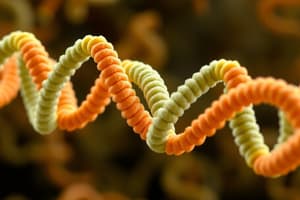Podcast
Questions and Answers
What are the major steps involved in the process of protein synthesis?
What are the major steps involved in the process of protein synthesis?
The major steps involved are transcription, where DNA is transcribed into mRNA, and translation, where ribosomes synthesize proteins using tRNA.
What is the role of tRNA in protein synthesis?
What is the role of tRNA in protein synthesis?
tRNA's role is to carry amino acids to the ribosome and pair with complementary codons on the mRNA during translation.
How does the genetic code ensure that multiple codons can code for the same amino acid?
How does the genetic code ensure that multiple codons can code for the same amino acid?
The genetic code consists of multiple codons that specify the same amino acid, allowing different tRNAs to transport the same building blocks.
What happens when a stop codon is reached during translation?
What happens when a stop codon is reached during translation?
What is the function of mRNA in the context of protein synthesis?
What is the function of mRNA in the context of protein synthesis?
Why can't tRNA have a stop codon?
Why can't tRNA have a stop codon?
In what way do DNA polymerases contribute to the transcription step of protein synthesis?
In what way do DNA polymerases contribute to the transcription step of protein synthesis?
How do peptide bonds form between amino acids during translation?
How do peptide bonds form between amino acids during translation?
Flashcards
What are proteins?
What are proteins?
Large molecules composed of chains of amino acids, essential for various bodily functions like transport, structure, enzymatic activity, and protection.
What is transcription?
What is transcription?
The process by which DNA's genetic code is transcribed into mRNA, which then carries the code out of the nucleus.
What is translation?
What is translation?
The process by which mRNA is translated into a protein using ribosomes.
What are amino acids?
What are amino acids?
Signup and view all the flashcards
What is mRNA?
What is mRNA?
Signup and view all the flashcards
What is tRNA?
What is tRNA?
Signup and view all the flashcards
What is a codon?
What is a codon?
Signup and view all the flashcards
What is a stop codon?
What is a stop codon?
Signup and view all the flashcards
Study Notes
Protein Synthesis
- Proteins are macromolecules composed of amino acids linked together in chains.
- Proteins are involved in various bodily functions, such as transporting materials, catalyzing reactions (enzymes), and structural support.
- Proteins are created inside ribosomes.
- DNA contains the protein instructions, which are transported out of the nucleus by mRNA.
Major Steps in Protein Synthesis
- Transcription: DNA is transcribed into a messenger RNA (mRNA) molecule inside the nucleus.
- DNA polymerase connects the coded message to complementary codons on mRNA.
- Translation: Ribosomes use mRNA to build proteins.
- Transfer RNA (tRNA) carries amino acids to the ribosome.
- tRNA molecules are complementary to mRNA codons.
- Amino acids are linked together to form a polypeptide chain.
Further Details
- mRNA reads codons in sets of three bases (a codon).
- tRNA molecules have complementary anticodon sequences that match the codons on mRNA.
- tRNA transfers specific amino acids to the ribosome based on the mRNA codon.
- Amino acids are linked together by peptide bonds.
- The process continues until a "stop" codon is reached, signifying the end of the protein.
- Multiple codons can code for the same amino acid.
- tRNA does not have a stop codon. Amino acids that complement the stop codon do not exist.
Studying That Suits You
Use AI to generate personalized quizzes and flashcards to suit your learning preferences.




